What can AI do for your business, really?
Dec. 4, 2020 | Source: Aidéo Technologies
It has been some 70 years since Alan Turing posed the question: Can machines think? And while there is no way Siri or Alexa can defeat the “Turing test” — a simple game that seeks to answer that question — there also is no doubt that machine learning and artificial intelligence are delivering massive global impact today, in ways seen and unseen.
In its many forms, artificial intelligence has revolutionized virtually every industry, from manufacturing and transportation to healthcare, sports, education and even politics and government. Yet many business leaders may struggle to understand what AI actually is and what it is not, what it actually does and what it does not do.
What can artificial intelligence do?
AI may refer to any number of technologies that are capable of performing tasks previously believed to require human intervention, from robotics and robotic process automation to machine learning and natural language processing.
A pair of researchers recently analyzed how more than 800 different AI systems were employed across 14 industries and determined that these systems’ capabilities fell into four distinct categories:
- Rote tasks, such as using robotic arms in manufacturing.
- Simple tasks that require ethical decision-making, such as using robots to assist people with disabilities.
- Creative tasks with limited ethical components, such as using AI finance tools to predict market changes or using surgical robots to execute complex procedures.
- Tasks with both creative and ethical components, such as using self-driving cars or search-and-rescue robots.
“There’s no easy answer when it comes to implementing AI in your business — and it’s only going to get more complicated as these systems continue to evolve and expand,” researchers Margherita Pagani and Renaud Champion wrote in the Harvard Business Review. “But armed with this simple framework, you can start to get a handle on the human capabilities you’ll need to develop in your team to make the most of the vast array of AI tools at your disposal.”
How can AI actually fit into a company’s work?
Because artificial intelligence can mean different things to different companies, there is no simple plug-and-play solution that covers the totality of the technology. But understanding the types of tasks a business needs to have performed — and the level of human oversight or intervention needed, depending on the ethical implications of the work — goes a long way toward demystifying the process.
“AI is not meant to take over decision-taking roles and replace humans in these tasks,” IBM’s Ann-Elise Delbecq said in an interview with Dataconomy. “Instead, embedding AI into existing business processes improves the decisions made at every single step.”
For businesses hoping to use AI or machine learning to improve workflow or processes, Delbecq said, proper data infrastructure is critical: “The first step is to centralize the data management and its governance: no more data silos, no more do-you-know-where-I-can-find-this-information type of question.”
Data scientists’ ability to build models that deliver meaningful insights is the critical component, so it’s imperative for the business to trust the technology — and to provide the contextual rules and access to every bit of data needed for it to function best. Put more simply: For machine learning to occur, there must be ample material from which machines can draw learnings.
So how should AI fit best into a business?
Just as AI itself is continually evolving, the collective understanding of how best to use it is evolving as well. But perhaps, as some analysts suggest, AI is most effective when “performing a task that is so boring that, despite there being value in that task, it would be a waste of time for a human to do it.”
Medical coding, for example, is a labor-intensive process that requires expertise in medical terminology, administrative procedures and an understanding of language. Pairing artificial intelligence with natural language processing for medical coding has been shown to improve processing speeds exponentially and to deliver significantly better accuracy than humans.
But the impact of artificial intelligence on medical coding goes beyond just these enhancements. It’s possible for hospitals to use machine learning to identify and correct processes that could lead to denied claims, for example, which can accelerate the payment process by reducing denials, a welcome advance as the financial fallout from COVID-19 worsens.
While this example shows that AI can be used to replace human labor for rote procedures and improve speed and accuracy in the process, it also illustrates the need for a different type of human skill set: the ability to interpret data and make critical business decisions as a result.
“Companies must have two types of people to unleash the potential of machine learning,” wrote the authors of a McKinsey & Company report on machine learning. “Quants are schooled in its language and methods. Translators can bridge the disciplines of data, machine learning, and decision making by reframing the quants’ complex results as actionable insights that generalist managers can execute.”
While machines may not be able to think like humans, they can learn, process and predict outcomes faster and more accurately. Any humans who seek to improve the speed and accuracy of their work products would do well, then, to apply their thought to how best to make use of AI and machine learning.





